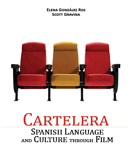Chapter Components
Colloquial Palestinian Arabic
An Introduction to the Spoken DialectStory & Dialogue
Each chapter opens with a carefully scripted dialogue that follows the story of three North American students and their Palestinian friends as they travel throughout Gaza, the West Bank and Jordan. The dialogues have been constructed in such a way so as to present students and instructors with examples of all aspects of colloquial Palestinian Arabic, including diction, syntax, intonation, and stress. Each chapter features one original dialogue that provides the basis for vocabulary, grammatical concepts, and cultural content introduced throughout the chapter.
Vocabulary and Cultural Expressions
New vocabulary and common expressions presented here are taken from the context of the main dialogue. Additional words and expressions (other than those mentioned in the dialogue) are added to provide active vocabulary that students may need when completing the rest of the chapter activities.
Active Use of Language and Cultural Concepts
The vocabulary and cultural concepts are enhanced by drills and content-based activities that may be conducted either in the classroom or assigned for completion outside of class. These activities will provide needed practice in both written and spoken Arabic but will focus on developing listening and speaking skills in a cultural context. Audio recordings of all chapter dialogues are performed by native speakers of Palestinian Arabic and provide students with a precise model for pronunciation and intonation.
Common verbs
Each chapter includes ten additional new verbs for study and practice. Giving students small doses of verbs in each chapter will facilitate their ability to master their use and incorporate them into their active vocabulary. This section is supplemented by practice activities which will help students utilize these verbs in real life situations.
Grammar
Grammar concepts are explained through clear, concise examples that will help learners freely use the language in a variety of cultural contexts and practical settings. All grammar explanations are provided in English with illustrative examples in Palestinian Arabic. It is suggested that students study the main grammar points on their own before coming to class, allowing more class time to be used for review, clarification, and active language production.
All grammar topics are linked directly to the main dialogue and related cultural concepts in each chapter. The natural design of the storyline serves to illustrate the grammatical structures, contextualize linguistic and cultural functions, and encourage overall language production. Students will find that they are quickly able to build upon and enhance their previously acquired language skills with each new lesson in Colloquial Palestinian Arabic and should be encouraged to work with grammar rules as a tool for language production. Each grammar lesson is supplemented with a variety of small group task-based and communicative exercises that may be done either in the classroom or at home.
Conversation and Real Life Situations
Each lesson features conversational practice activities that include examples of the functions, expressions, and cultural concepts that are covered in the lesson. Conversation equips students with the ability to express themselves freely using their own input and thoughts. In real life situations, students will also learn to incorporate recycled vocabulary, expressions, and cultural concepts in a multitude of new settings.
More New Expressions and Conjunctions
More commonly used expressions and conjunctions are included in this section to help students gain a better understanding of the Palestinian language and culture.
Learn More about Palestinian Culture
Each chapter is concluded with a presentation of new cultural concepts and settings provided in both English and Palestinian Arabic. Culture is an essential part of the language learning experience and is carefully incorporated in the practice activities of each chapter to provide students with the tools they need for a successful journey to learn the Palestinian language and culture.



